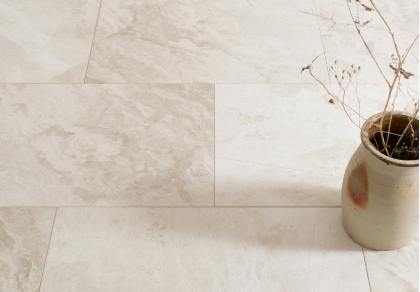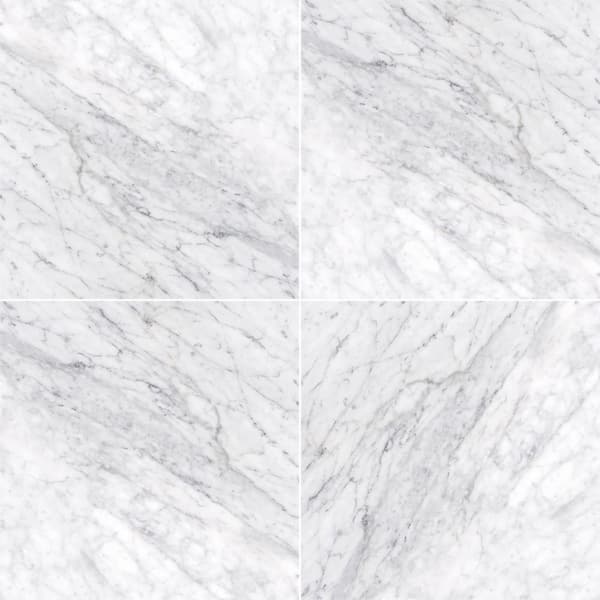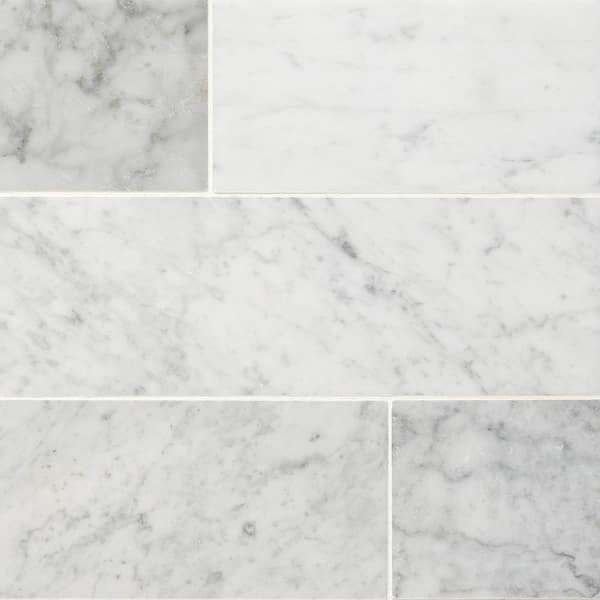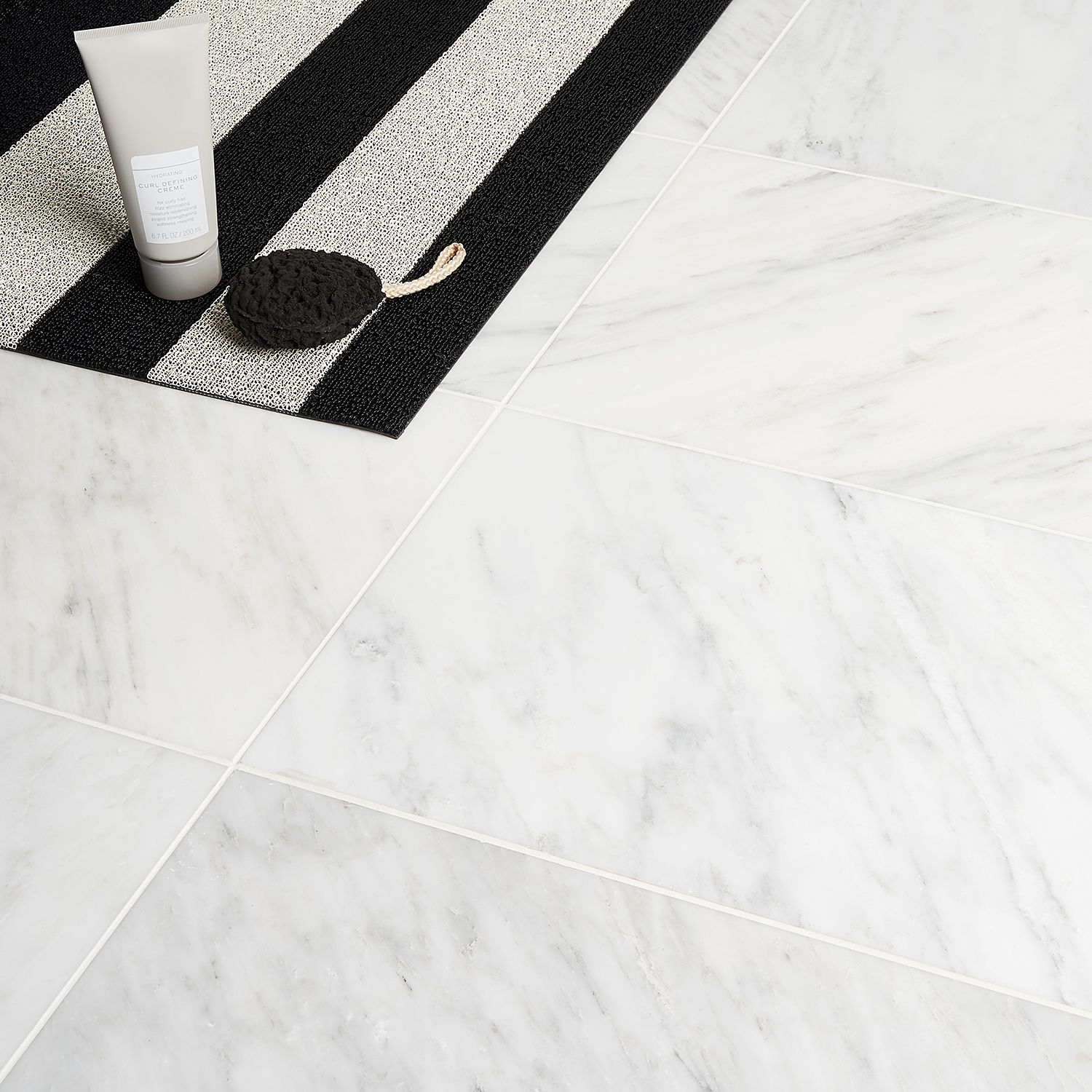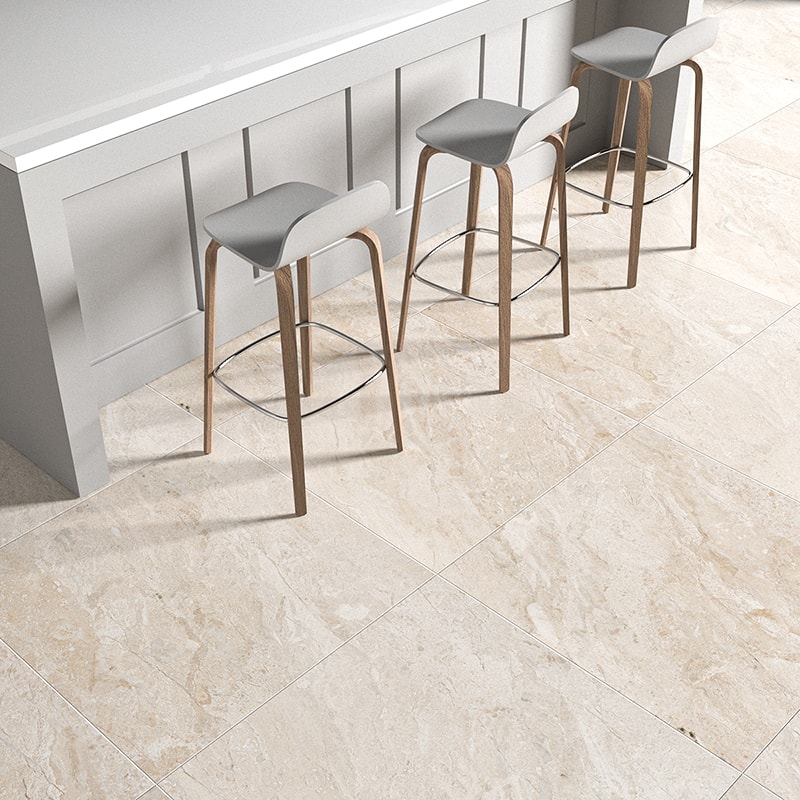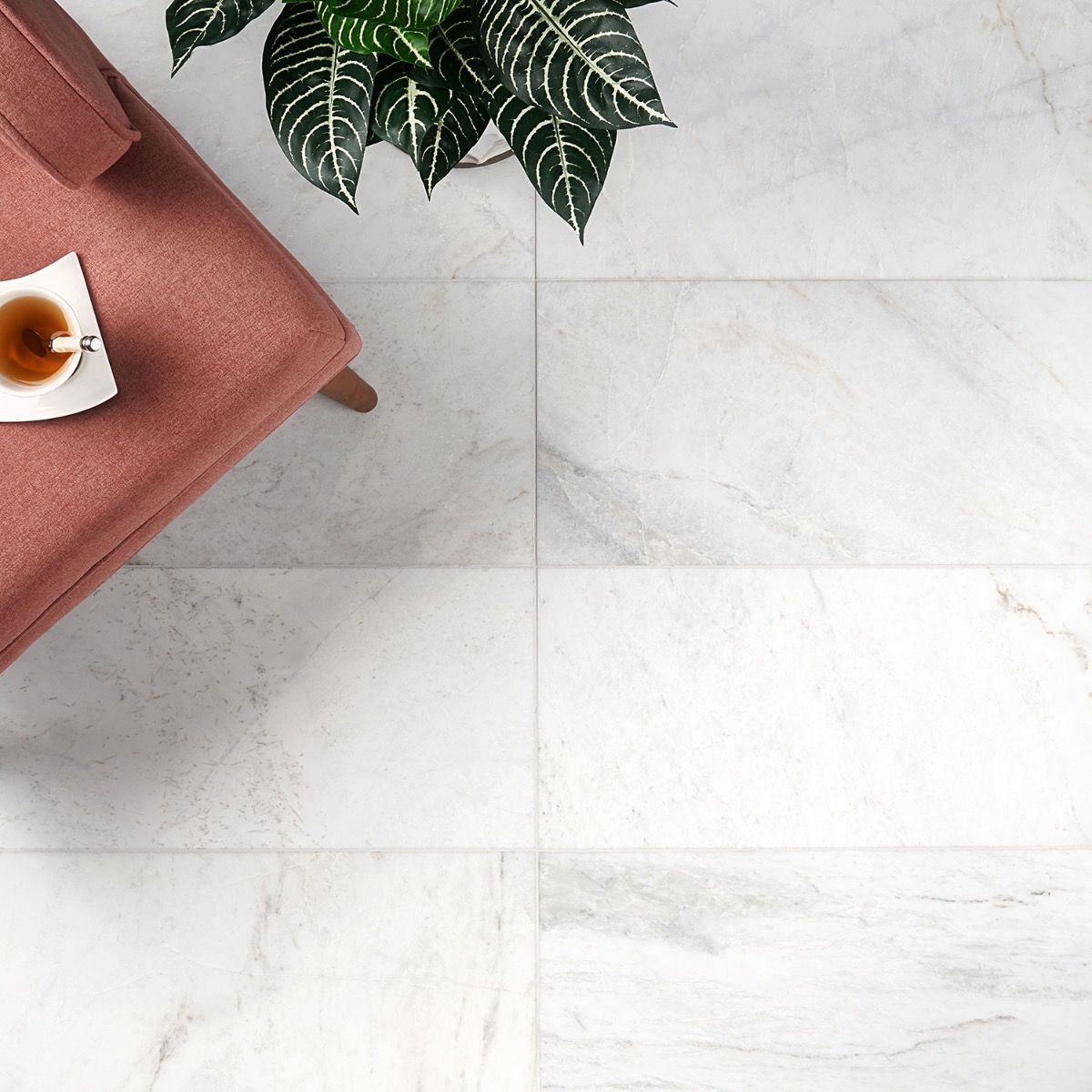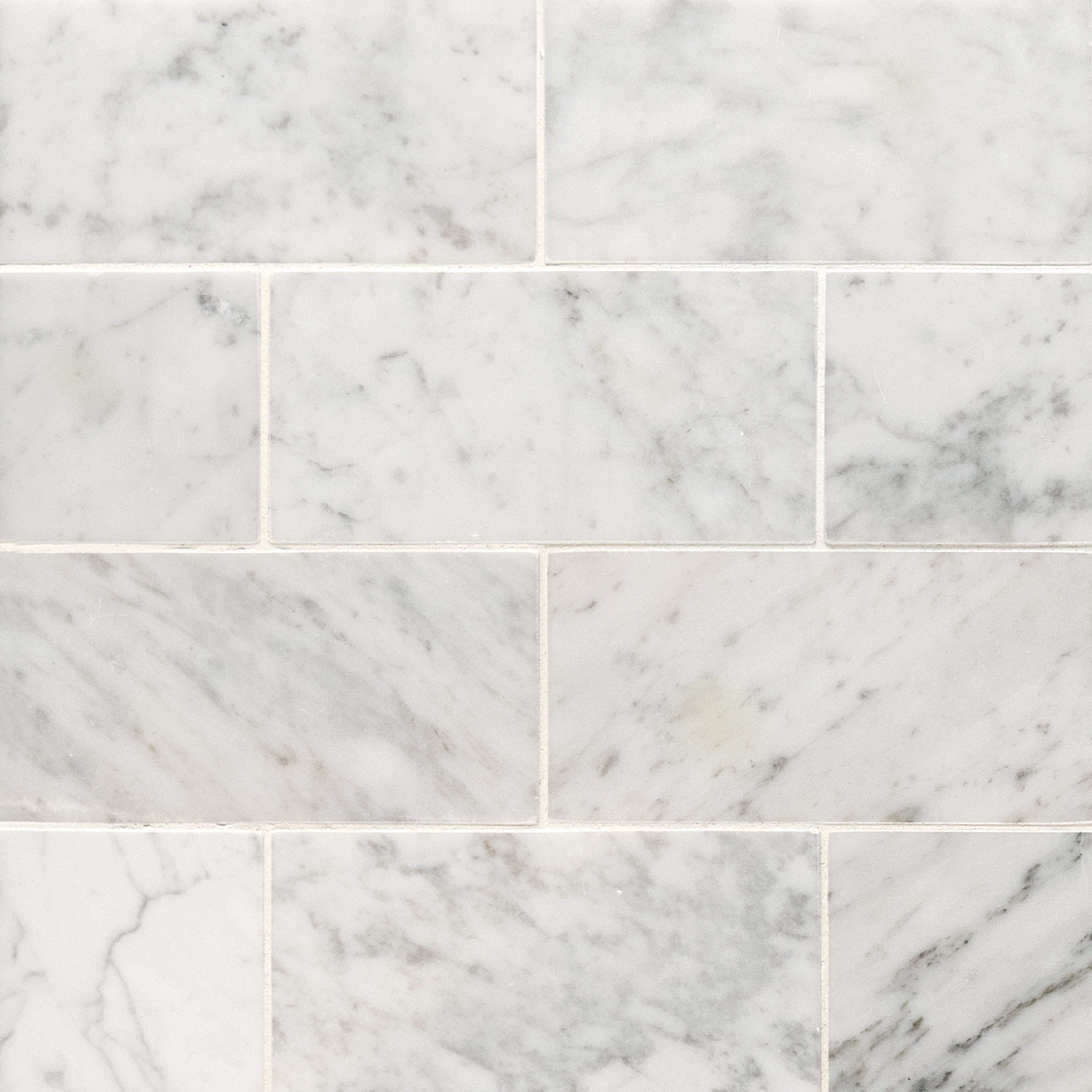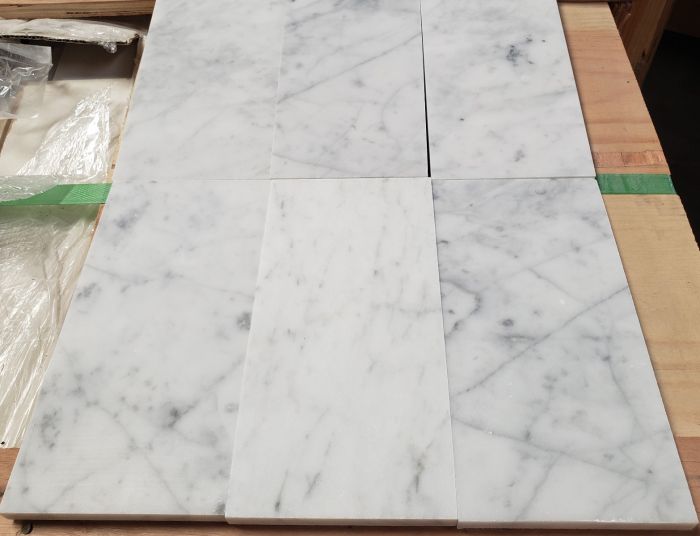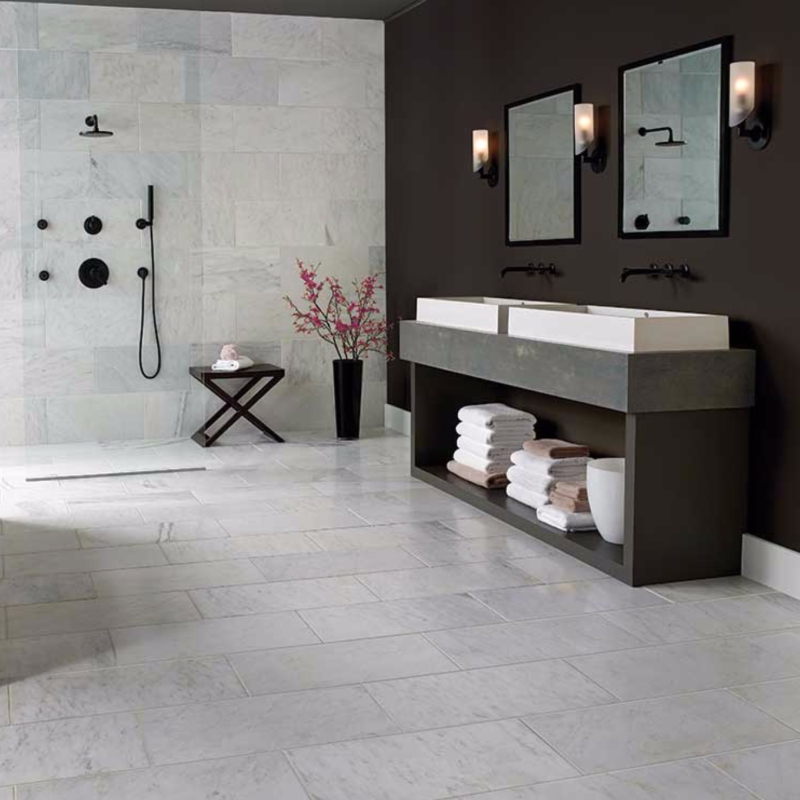Honed Marble Floor Tile: An Introduction to Its Unique Appeal
When it comes to selecting flooring for your home, the allure of marble is undeniable. However, within the realm of marble flooring, honed marble tiles offer a unique appeal that stands out for its understated elegance and practical advantages. Honed marble is characterized by its smooth, matte finish, which sets it apart from the more traditional polished marble. Let’s discuss the key features of honed marble floor tiles and why they might be the perfect choice for your space.
- A Timeless Aesthetic: Honed marble exudes a timeless beauty that effortlessly elevates the look of any room. Unlike polished marble, which has a glossy, reflective surface, honed marble offers a soft, satin-like finish. This muted sheen lends a subtle sophistication to spaces, making it ideal for those who prefer a more subdued, classic look. I find that honed marble tiles work particularly well in creating a calm, serene atmosphere, whether used in a bathroom, kitchen, or entryway.
- Slip-Resistance: One of the most practical benefits of honed marble tiles is their slip-resistant surface. Because the finish is matte rather than glossy, honed marble offers better traction, reducing the risk of slips and falls. This makes it an excellent choice for areas where water or moisture is present, such as bathrooms, kitchens, and outdoor spaces. As someone who values both style and safety, I appreciate how honed marble tiles strike a balance between the two.
- Durability and Longevity: Marble is a durable natural stone, and honed marble is no exception. While all marble requires proper care, honed marble is less prone to scratches and wear than its polished counterpart. The matte finish helps to conceal minor imperfections, making it a practical option for high-traffic areas. I’ve found that with regular maintenance, honed marble floors can retain their beauty for decades, becoming a lasting investment in your home.
- Versatility in Design: Honed marble tiles come in a variety of colors, patterns, and sizes, offering endless possibilities for design. Whether you’re aiming for a monochromatic look with classic white or grey marble, or you want to make a statement with bold, veined patterns, honed marble can be tailored to suit your vision. I love how the subtle texture of honed marble adds depth to a room without overwhelming the overall design.
- Ease of Maintenance: Maintaining honed marble floors is relatively straightforward, especially when compared to polished marble. The matte finish does not show water spots, fingerprints, or smudges as easily, which means less frequent cleaning is required. Additionally, because honed marble is less likely to etch from acidic substances, it’s a more forgiving option in spaces where spills are common, such as kitchens and dining areas.
- Environmental Considerations: For those who are environmentally conscious, honed marble is a natural, sustainable choice. Marble is a naturally occurring stone that is quarried and cut, making it a more eco-friendly option compared to synthetic materials. Additionally, the long lifespan of honed marble means that it won’t need to be replaced as frequently, reducing waste over time. Choosing honed marble for your floors is a decision that can contribute to a more sustainable home environment.

Comparing Honed vs. Polished Marble: What Sets Honed Marble Apart
When deciding between honed and polished marble, it’s important to understand the differences between the two finishes. Each has its unique characteristics, and the choice ultimately depends on your aesthetic preferences and practical needs. Let’s find out what sets honed marble apart from polished marble, helping you make an informed decision for your flooring project.
Finish and Texture: The most obvious difference between honed and polished marble is the finish. Polished marble has a high-gloss, reflective surface that creates a mirror-like effect, while honed marble has a smooth, matte finish. I find that the matte texture of honed marble offers a more natural, organic feel, which can be appealing to those who want to create a relaxed, inviting space. On the other hand, polished marble’s shiny surface is ideal for adding a touch of luxury and drama to a room.
Visual Impact: The finish of the marble also affects its visual impact. Polished marble’s reflective surface can make a room appear larger and brighter by bouncing light around the space. This makes it a popular choice for small or dimly lit areas. However, the glossy finish can also highlight imperfections such as scratches, smudges, and etching. Honed marble, with its non-reflective surface, offers a more understated elegance. I appreciate how honed marble’s finish tends to minimize the appearance of imperfections, making it a great choice for busy households.
Scratch and Etch Resistance: One of the key advantages of honed marble is its resistance to scratches and etching. Polished marble is more susceptible to these issues due to its smooth, shiny surface, which can easily show marks from sharp objects or acidic substances. In contrast, honed marble’s matte finish is less likely to show scratches, and it’s more resistant to etching from acidic foods and liquids. For me, this makes honed marble a more practical choice for areas like kitchens and bathrooms, where spills are more likely to occur.
Maintenance Requirements: The maintenance requirements for honed and polished marble differ as well. Polished marble requires more frequent cleaning to maintain its glossy appearance, as it shows smudges, fingerprints, and water spots more easily. Additionally, polished marble may need to be re-polished periodically to restore its shine if it becomes dull or scratched. Honed marble, on the other hand, is easier to maintain because it does not show marks as readily. I find that regular sweeping and mopping are usually sufficient to keep honed marble floors looking their best.
Slip Resistance: Another important factor to consider is slip resistance. Polished marble, with its smooth, glossy surface, can be quite slippery when wet, making it a less ideal choice for areas prone to moisture. Honed marble, with its matte finish, offers better traction and is therefore safer for use in bathrooms, kitchens, and outdoor areas. For families with young children or elderly members, the slip resistance of honed marble is a significant advantage.
Aesthetic Flexibility: While both honed and polished marble are available in a wide range of colors and patterns, the finish can affect the overall aesthetic of the space. Polished marble’s high-gloss finish tends to create a more formal, elegant look, making it well-suited for grand entrances, formal dining rooms, or opulent bathrooms. In contrast, honed marble’s soft, matte finish lends itself to a more casual, relaxed atmosphere, which I find perfect for cozy living spaces, serene bathrooms, or rustic kitchens.
Benefits of Choosing Honed Marble Floor Tiles for Your Home
Honed marble floor tiles offer a range of benefits that make them a desirable choice for homeowners looking to combine beauty with functionality. Whether you’re renovating your home or building a new one, honed marble tiles can provide a stylish and durable flooring option. Let’s outline the key benefits of choosing honed marble floor tiles, drawing from both practical and aesthetic perspectives.
Timeless Beauty: One of the most compelling reasons to choose honed marble floor tiles is their timeless beauty. Marble has been used in architecture and design for centuries, and its classic appeal has endured through various design trends. The soft, matte finish of honed marble enhances its natural elegance, making it a versatile option that can complement a wide range of interior styles, from traditional to contemporary. I love how honed marble adds a touch of sophistication to any room without overpowering the overall design.
Enhanced Durability: Durability is another significant advantage of honed marble floor tiles. Marble is a naturally strong and durable stone, and the honed finish further enhances its resilience. Unlike polished marble, which can show scratches and etching more readily, honed marble is better suited to withstand the wear and tear of everyday life. This makes it an excellent choice for high-traffic areas such as hallways, kitchens, and living rooms, where durability is essential.
Increased Safety: Safety is always a priority, especially in areas like bathrooms and kitchens where moisture is present. Honed marble floor tiles offer increased slip resistance compared to polished marble, thanks to their matte finish. This makes them a safer option for households with children, elderly members, or anyone concerned about slips and falls. I find that honed marble’s slip-resistant surface provides peace of mind without sacrificing style.
Low Maintenance: Keeping honed marble floors looking their best is relatively easy, which is a major benefit for busy homeowners. The matte finish of honed marble does not show dirt, dust, or smudges as easily as polished marble, meaning you won’t have to clean it as frequently. Additionally, honed marble is less likely to show water spots or fingerprints, which can be a common issue with glossy finishes. Regular sweeping and occasional mopping are usually all that’s needed to maintain the beauty of honed marble floors.
Versatility in Design: Honed marble floor tiles are incredibly versatile in terms of design. They are available in a wide range of colors, patterns, and sizes, allowing you to create a custom look that suits your style and the aesthetic of your home. Whether you prefer the classic elegance of white Carrara marble or the bold, dramatic veining of Calacatta, honed marble tiles can be used to achieve a variety of design effects. I particularly appreciate how the matte finish of honed marble adds texture and depth to a space without overpowering the other design elements.
Environmental Friendliness: For those who prioritize sustainability, honed marble is a natural and environmentally friendly choice. Marble is a renewable resource that is quarried from the earth, and its long lifespan means that it doesn’t need to be replaced as frequently as other flooring materials. Additionally, marble is a hypoallergenic material that does not harbor dust, mold, or allergens, contributing to a healthier indoor environment. Choosing honed marble floor tiles is a decision that aligns with both style and environmental responsibility.
Installation Process: How to Lay Honed Marble Floor Tiles
Installing honed marble floor tiles requires careful planning and precision to ensure a flawless result. While the process can be complex, understanding the steps involved can help you achieve a professional-looking finish. Let me walk you through the installation process for honed marble floor tiles, offering tips and insights based on my own experience.
Preparing the Subfloor: The first step in the installation process is to prepare the subfloor. A clean, level and stable subfloor is essential for a successful installation, as any imperfections can affect the final result. Start by thoroughly cleaning the subfloor to remove any dust, debris, or old adhesive. Next, check for any uneven areas and use a leveling compound to create a smooth surface. In my experience, taking the time to properly prepare the subfloor is crucial for preventing issues like lippage or uneven tiles later on.
Planning the Layout: Before you start laying the tiles, it’s important to plan the layout. This involves dry-fitting the tiles to determine the best placement and pattern. Begin by finding the center of the room and marking guidelines on the subfloor to ensure the tiles are aligned properly. I like to use spacers to maintain consistent grout lines and to avoid any surprises when it’s time to install the tiles permanently. Planning the layout also allows you to make any necessary adjustments to the design before the adhesive is applied.
Applying the Adhesive: Once the layout is finalized, it’s time to apply the adhesive. Use a notched trowel to spread a thin layer of adhesive on the subfloor, working in small sections to prevent the adhesive from drying out before the tiles are laid. Be sure to use an adhesive that is specifically designed for natural stone, as this will ensure a strong bond. I’ve found that applying the adhesive in a consistent, even layer helps to prevent issues like lippage and ensures that the tiles are properly secured.
Laying the Tiles: With the adhesive in place, you can begin laying the honed marble tiles. Start at the center of the room and work your way outwards, pressing each tile firmly into the adhesive to ensure a good bond. Use spacers to maintain even grout lines, and periodically check that the tiles are level. If you notice any unevenness, gently adjust the tile while the adhesive is still wet. Laying the tiles is a meticulous process, but taking your time will result in a more professional-looking finish.
Grouting the Tiles: After the tiles have been laid and the adhesive has had time to set, the next step is to grout the tiles. Choose a grout color that complements the marble and enhances the overall design. Use a rubber grout float to spread the grout over the tiles, pressing it into the joints to fill the gaps. Once the grout is applied, use a damp sponge to wipe away any excess grout from the surface of the tiles. I recommend working in small sections and cleaning the tiles as you go to prevent the grout from hardening on the surface.
Sealing the Marble: The final step in the installation process is to seal the honed marble tiles. Sealing is essential for protecting the marble from stains, moisture, and other potential damage. Choose a high-quality sealer that is specifically formulated for natural stone, and apply it according to the manufacturer’s instructions. In my experience, sealing the marble not only enhances its durability but also brings out the natural beauty of the stone. Be sure to reapply the sealer periodically to maintain its protective properties.
Design Ideas: Enhancing Your Space with Honed Marble Floor Tiles
Honed marble floor tiles offer endless design possibilities, making them a versatile choice for any room in your home. Whether you’re looking to create a modern, minimalist space or a classic, timeless interior, honed marble can be tailored to suit your style. Below are some design ideas for enhancing your space with honed marble floor tiles, drawing inspiration from various interior design trends.
Classic Elegance with White Marble: White honed marble, such as Carrara or Calacatta, is a classic choice that never goes out of style. Its clean, crisp appearance can make any room feel more spacious and bright. I love using white honed marble floor tiles in bathrooms and kitchens, where they create a sense of calm and purity. Pairing white marble with white cabinetry and chrome fixtures can create a timeless, elegant look that’s both fresh and inviting.
Bold Statement with Dark Marble: For a more dramatic effect, consider using dark honed marble floor tiles. Black or deep gray marble, such as Nero Marquina or Pietra Gray, can add depth and sophistication to a space. I find that dark marble works particularly well in larger rooms, where it can create a striking contrast with lighter walls and furnishings. To prevent the room from feeling too heavy, balance the dark marble with plenty of natural light and reflective surfaces.
Mixed Patterns and Textures: Mixing different patterns and textures is a great way to add visual interest to a space. Consider combining honed marble floor tiles with other materials, such as wood or metal, to create a unique, layered look. For example, pairing honed marble with reclaimed wood accents can add warmth and texture to a room, while metal fixtures can introduce a touch of industrial chic. I enjoy experimenting with different combinations to create a design that feels both cohesive and dynamic.
Geometric Patterns: Geometric patterns are a popular design trend that can add a modern twist to traditional marble flooring. Consider arranging honed marble tiles in a herringbone, chevron, or basketweave pattern to create a striking focal point in the room. These patterns can add movement and energy to the space, making it feel more dynamic and contemporary. I find that geometric patterns work well in both small and large rooms, depending on the scale of the pattern and the size of the tiles.
Monochromatic Schemes: A monochromatic color scheme is a sophisticated design choice that can create a harmonious, cohesive look. Consider using honed marble floor tiles in a single color, such as gray or beige, and pairing them with walls, furniture, and accessories in similar shades. This creates a seamless, unified design that feels both elegant and serene. I particularly like how a monochromatic scheme allows the natural beauty of the marble to take center stage, without competing with other elements in the room.
Accent Borders and Inlays: Adding accent borders or inlays to honed marble floor tiles can elevate the design and create a custom look. Consider using a contrasting marble or mosaic tiles to create a border around the perimeter of the room or to define specific areas, such as a dining area or entryway. Inlays can also be used to create intricate patterns or motifs within the floor design. I find that accent borders and inlays add a touch of luxury and craftsmanship to the space, making it feel more personalized and unique.
Maintenance Tips: Keeping Your Honed Marble Floors Looking Their Best
Honed marble floors are a beautiful and durable choice, but like any natural stone, they require proper care to maintain their appearance. With the right maintenance routine, you can keep your honed marble floors looking as stunning as the day they were installed. Let me share some essential maintenance tips to help you preserve the beauty and longevity of your honed marble floors.
Regular Cleaning: Regular cleaning is the cornerstone of maintaining honed marble floors. To keep your floors free of dust, dirt, and debris, sweep or vacuum them regularly. I recommend using a soft-bristled broom or a vacuum cleaner with a hard floor attachment to avoid scratching the surface. For deeper cleaning, use a pH-neutral stone cleaner and a damp mop. Avoid using acidic or abrasive cleaners, as they can damage the marble and dull the finish.
Spill Management: Spills are inevitable, especially in areas like kitchens and dining rooms. However, it’s important to clean up spills immediately to prevent staining. Because honed marble is more porous than polished marble, it can absorb liquids more easily, leading to potential stains. I keep a microfiber cloth or paper towels on hand to blot up spills as soon as they occur. For tougher stains, you can use a poultice made from baking soda and water to draw the stain out of the marble.
Sealing the Marble: Sealing is a crucial step in protecting honed marble floors from stains and moisture. I recommend sealing your honed marble floors upon installation and reapplying the sealer every 6 to 12 months, depending on the level of foot traffic. Choose a high-quality, penetrating sealer that is specifically designed for natural stone. Sealing the marble not only protects it from stains but also makes it easier to clean and maintain.
Avoiding Scratches: While honed marble is more resistant to scratches than polished marble, it’s still important to take precautions to avoid damage. Place felt pads under furniture legs to prevent scratches when moving furniture. In high-traffic areas, consider using rugs or runners to protect the floor from wear and tear. I also recommend keeping pet nails trimmed and avoiding walking on the marble with high heels, as these can cause scratches or dents on the surface.
Dealing with Etching: Etching occurs when acidic substances, such as lemon juice, vinegar, or wine, come into contact with marble, leaving a dull mark on the surface. While honed marble is less prone to etching than polished marble, it can still occur. If you notice etching on your honed marble floors, you can use a marble polishing powder or a professional-grade etch remover to restore the finish. I’ve found that addressing etching as soon as it occurs helps to minimize the damage and keep the marble looking its best.
Periodic Deep Cleaning: In addition to regular cleaning, it’s a good idea to give your honed marble floors a periodic deep cleaning to remove any built-up dirt or grime. You can do this by using a steam cleaner or by mopping the floor with a mixture of warm water and a few drops of mild dish soap. Be sure to rinse the floor thoroughly with clean water and dry it with a soft towel to prevent water spots. I find that deep cleaning the marble every few months helps to maintain its natural luster and beauty.
Common Issues and Solutions for Honed Marble Floor Tiles
While honed marble floor tiles are a durable and beautiful choice, they can still encounter some common issues over time. Understanding these potential problems and knowing how to address them can help you keep your floors looking their best for years to come. In this section, I’ll explore some of the most common issues with honed marble floor tiles and offer practical solutions for each.
Staining: Staining is one of the most common issues with honed marble floor tiles, due to their porous nature. Spills from coffee, wine, or acidic foods can penetrate the surface of the marble and leave unsightly stains. To prevent staining, it’s essential to seal the marble regularly and clean up spills immediately. If a stain does occur, you can use a poultice made from baking soda and water to draw out the stain. I’ve found that applying the poultice and leaving it to dry overnight can often remove even stubborn stains.
Etching: Etching is another common issue with honed marble, caused by contact with acidic substances like lemon juice, vinegar, or tomato sauce. Etching can leave a dull, whitish mark on the surface of the marble, which can be difficult to remove. To minimize the risk of etching, avoid using acidic cleaners and wipe up spills as soon as they occur. If etching does happen, you can use a marble polishing powder or a professional-grade etch remover to restore the finish. I recommend following the manufacturer’s instructions carefully to achieve the best results.
Scratches: While honed marble is more resistant to scratches than polished marble, it can still be scratched by sharp objects or heavy furniture. To prevent scratches, use felt pads under furniture legs and avoid dragging heavy items across the floor. In high-traffic areas, consider using rugs or runners to protect the marble. If scratches do occur, they can often be minimized by using a marble polishing powder or by having the floor professionally polished. I’ve found that addressing scratches promptly can help maintain the appearance of the marble.
Lippage: Lippage occurs when one tile is set higher or lower than the adjacent tiles, creating an uneven surface. This can happen during the installation process if the subfloor is not properly prepared or if the tiles are not installed evenly. To avoid lippage, it’s important to ensure that the subfloor is level and that the tiles are laid with consistent spacing. If lippage is detected after installation, it can sometimes be corrected by grinding down the high spots, although this should be done by a professional.
Dullness: Over time, honed marble floors can become dull due to foot traffic, dirt, and wear. To restore the natural beauty of the marble, you can use a marble polishing powder or a stone cleaner specifically designed for natural stone. I recommend giving the floor a periodic deep cleaning to remove any built-up dirt or grime that may be dulling the surface. If the marble remains dull, it may need to be professionally honed or polished to restore its original luster.
Water Spots: Water spots can occur on honed marble floors, particularly in areas where water is frequently present, such as bathrooms or kitchens. These spots are usually caused by mineral deposits left behind when water evaporates. To prevent water spots, wipe up water spills immediately and dry the floor with a soft towel. If water spots do occur, they can often be removed with a mild stone cleaner or a mixture of water and a few drops of dish soap. I’ve found that regular sealing can also help to minimize the appearance of water spots.
Alaska White 12×24 Honed Marble Tile
Carrara 3″ x 6″ Natural Stone Marble Look Subway Wall & Floor Tile
White Carrara 4X8 Honed Marble Tile
Popular Marble Floor Finishes: Polished, Honed, and Tumbled
Related Posts:
